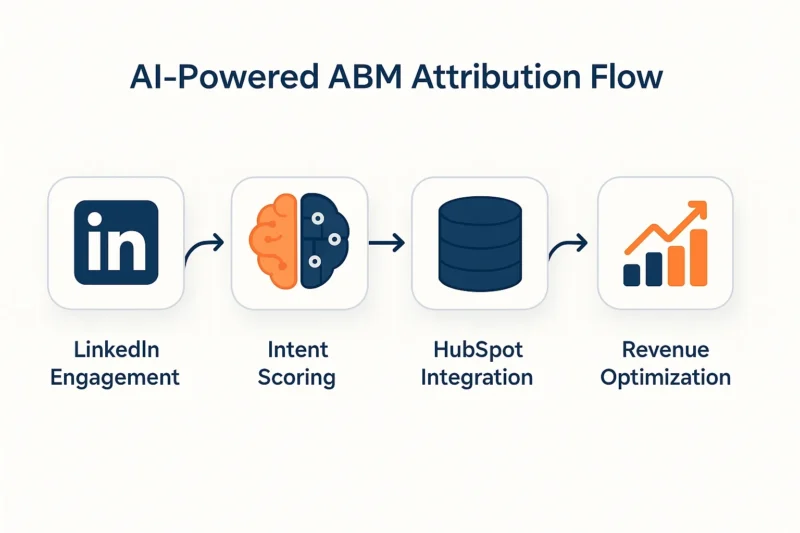How to Use AI for LinkedIn ABM Revenue Tracking in HubSpot
Revenue attribution has become the ultimate battleground for B2B marketing teams in 2025. While LinkedIn ABM campaigns generate impressive engagement metrics, translating those interactions into measurable revenue impact inside HubSpot remains frustratingly complex for most organizations. The solution lies in AI-powered attribution systems that can untangle multi-touch customer journeys and assign accurate revenue credit to each LinkedIn touchpoint.
The challenge isn’t just technical, it’s strategic. Marketing teams need to prove that their LinkedIn ABM investments directly contribute to closed deals, while sales teams require prioritized account lists based on actual buying signals rather than vanity metrics. AI transforms this equation by automating the complex data analysis required to track LinkedIn engagement through to revenue outcomes in HubSpot.
TABLE OF CONTENTS:
Why AI-Enhanced LinkedIn ABM Integration Drives Revenue Growth
The foundation for effective AI-powered revenue tracking starts with understanding why LinkedIn and HubSpot integration has become essential for modern ABM strategies. Research from Single Grain shows that 87% of ABM-focused HubSpot users had adopted LinkedIn integrations by early 2024, creating a rich data layer that AI can analyze for revenue attribution.
This widespread adoption creates both opportunity and urgency. Organizations that leverage AI to extract deeper insights from their LinkedIn-HubSpot integration gain significant competitive advantages in account prioritization, personalization, and revenue forecasting. The key lies in moving beyond basic lead tracking to comprehensive account-level revenue attribution.
“The integration of AI into LinkedIn ABM revenue tracking transforms marketing from a cost center into a measurable revenue driver. We can now precisely identify which LinkedIn touchpoints contribute to closed deals and optimize our entire funnel accordingly.” – VP of Marketing, Enterprise SaaS Company
AI enhances this integration by automatically categorizing engagement quality, predicting account readiness, and attributing revenue across complex multi-touch journeys. Instead of relying on last-click attribution that undervalues LinkedIn’s influence, AI models can assign appropriate credit to each touchpoint based on its actual impact on deal progression.
Building Your AI Attribution Foundation in HubSpot
Successful AI-powered LinkedIn ABM revenue tracking requires a systematic approach to data architecture and attribution modeling. The foundation begins with ensuring a clean and comprehensive data flow between LinkedIn Campaign Manager, HubSpot CRM, and any third-party intent data providers.
The first step involves mapping your LinkedIn campaign structure to HubSpot’s account hierarchy. This means ensuring that every LinkedIn ad interaction can be traced back to specific accounts in your HubSpot database, not just individual contacts. AI attribution models require this account-level view to properly assess buying committee engagement and assign revenue credit accurately.
| Integration Component | Data Points Captured | AI Enhancement Opportunity |
|---|---|---|
| LinkedIn Campaign Manager | Impressions, clicks, engagement rates, lead form submissions | Intent scoring, engagement quality assessment |
| HubSpot CRM | Contact interactions, deal progression, revenue outcomes | Predictive scoring, attribution modeling |
| Third-party Intent Data | Website visits, content consumption, search behavior | Account readiness prediction, timing optimization |
The second critical component involves choosing the right attribution model for your sales cycle. AI-powered attribution goes beyond simple first-touch or last-touch models by dynamically weighting touchpoints based on their demonstrated impact on deal velocity and win rates. This requires historical data analysis to train the AI model on the actual engagement patterns that correlate with revenue outcomes.
Implementing Multi-Touch Attribution Models
The most successful AI-powered LinkedIn ABM programs use sophisticated attribution models that account for the complex nature of B2B buying processes. According to RollWorks research, companies aligning ABM with account-based advertising (including LinkedIn Ads) see 60% higher win rates, which AI can further amplify through predictive scoring and attribution models.
Position-based attribution models work particularly well for LinkedIn ABM because they recognize that LinkedIn often plays a dual role in the buyer’s journey, serving both awareness and consideration stages. AI enhances these models by automatically adjusting the attribution weights based on deal characteristics, account size, and industry patterns learned from historical data.
The implementation process requires setting up tracking for every possible LinkedIn touchpoint, including organic engagement, paid advertising interactions, and even passive content consumption. AI systems can then analyze these touchpoints in context with other marketing activities and sales interactions to build a comprehensive view of what actually drives revenue.
Real-World Success: End-to-End AI Attribution
BioCatch, an enterprise cybersecurity company, exemplifies the transformative potential of AI-powered LinkedIn ABM revenue tracking. Facing pressure to grow their enterprise pipeline while proving ROI, they implemented a comprehensive AI attribution system connecting LinkedIn Campaign Manager, intent data providers, and HubSpot CRM.
Their AI-powered attribution engine logged every paid, organic, and sales touch at the account level, scored engagement with AI intent signals, and continuously re-optimized LinkedIn ads and HubSpot workflows based on multi-touch revenue impact. The results were remarkable: a 5× increase in qualified pipeline within six months on the identical target-account list, with revenue credit precisely tied to the LinkedIn ABM sequences identified by the AI attribution model.

This success story highlights the crucial importance of integrating AI intent scoring with multi-touch attribution within HubSpot. The system could identify not just which accounts were engaging with LinkedIn content, but which specific types of engagement predicted actual deal progression and revenue outcomes.
Overcoming Attribution Challenges with AI
One of the most significant challenges in LinkedIn ABM revenue tracking is the persistent problem of last-click bias. Traditional attribution models often undervalue LinkedIn’s contribution because LinkedIn typically operates in the early and middle stages of the buyer’s journey, while final conversions happen through direct sales interactions or other channels.
Fibbler, a marketing technology company, faced exactly this challenge. Their native LinkedIn-to-HubSpot syncs missed impressions and mid-funnel engagements, forcing marketers into last-click reporting that undervalues LinkedIn’s revenue contribution. The solution involved layering an AI-powered attribution platform on top of their standard LinkedIn-HubSpot integration.
The AI model captured every impression, click, and share, then reassigned revenue credit across first, middle, and last touches based on their actual influence on deal outcomes. This resulted in more accurate revenue reporting, enabled automatic lead syncing and prioritization for sales, and increased ROI on LinkedIn ad spend through budget reallocation to high-influence campaigns.
The key insight from Fibbler’s experience is that AI attribution reveals LinkedIn’s actual multi-touch influence, unlocking more intelligent budget allocation and sales follow-up decisions. This level of accuracy becomes particularly valuable when justifying LinkedIn ABM budgets to executive stakeholders who demand clear revenue correlation.
Scaling AI Attribution Across Enterprise ABM Programs
Enterprise-level ABM programs require attribution systems that can handle thousands of accounts, multiple buying committee members per account, and complex sales cycles spanning months or years. RollWorks’ approach to this challenge illustrates how AI can deliver both targeting precision and revenue attribution at scale.
Their AI-driven predictive analytics system, integrated with HubSpot, syncs dynamic ICP audiences into LinkedIn, applies multi-touch attribution to every ad, email, and site visit, and surfaces high-fit accounts to sales teams inside HubSpot. This approach resulted in improved targeting precision and faster sales cycles, while giving marketers the ability to measure the contribution of each LinkedIn ABM touchpoint to both pipeline creation and closed-won revenue.
The scalability factor becomes crucial for organizations managing large account lists. AI systems can simultaneously track attribution for thousands of accounts, identify pattern differences across industries or company sizes, and continuously optimize both targeting and attribution models based on emerging data patterns.
Measuring and Optimizing Revenue Impact
The ultimate goal of AI-powered LinkedIn ABM revenue tracking is not just measurement but continuous optimization. Research from Huble indicates that ABM adoption can drive a 208% increase in revenue growth, underscoring the value of precise, AI-enabled revenue tracking inside HubSpot.
Effective optimization requires establishing baseline metrics before implementing AI-powered attribution, then tracking improvements in key performance indicators such as deal velocity, win rates, and average deal size. AI systems excel at identifying which specific LinkedIn ABM tactics drive the most significant improvements in these metrics.
The optimization process should focus on three key areas: account selection refinement based on AI-identified success patterns, message personalization driven by engagement prediction models, and budget allocation optimization based on true revenue attribution rather than traditional campaign metrics.
Your 90-Day Implementation Roadmap
Implementing AI-powered LinkedIn ABM revenue tracking requires a structured approach that balances technical setup with strategic planning. The following roadmap provides a practical path to achieving measurable results within 90 days.
Days 1-30: Foundation Setup
Establish clean data integration between LinkedIn Campaign Manager and HubSpot, ensuring proper account mapping and contact attribution. Implement baseline tracking for all LinkedIn touchpoints, including organic engagement and paid advertising interactions. Begin collecting historical data for AI model training.
Days 31-60: AI Model Deployment
Deploy AI attribution models using historical data to establish initial weightings for different touchpoint types. Begin testing predictive engagement scoring to identify high-intent accounts. Implement automated workflows in HubSpot based on AI-generated account prioritization.
Days 61-90: Optimization and Scaling
Analyze initial attribution results and refine AI models based on observed revenue correlations to optimize performance. Expand tracking to include additional data sources such as intent data providers or marketing automation platforms. Begin optimizing LinkedIn ad targeting and budget allocation based on AI attribution insights.
Organizations looking to accelerate this implementation process can benefit from specialized ABM platforms that provide pre-built AI attribution capabilities. Tools like Karrot.ai offer automated personalization and attribution tracking specifically designed for LinkedIn ABM programs integrated with HubSpot, enabling faster deployment and more sophisticated attribution modeling.
Transforming ABM Performance Through AI-Driven Insights
The future of LinkedIn ABM revenue tracking lies in AI systems that can automatically optimize targeting, personalization, and attribution in real-time. Organizations that implement comprehensive AI attribution systems today position themselves to capture significantly more value from their LinkedIn ABM investments while providing the revenue accountability that executive stakeholders demand.
Success requires moving beyond basic integration to sophisticated AI-powered attribution that can handle the complexity of modern B2B buying processes. The organizations achieving 5× pipeline growth and 60% higher win rates are those that have embraced AI as the core engine driving both their LinkedIn ABM strategy and their HubSpot revenue tracking.
The time to implement AI-powered LinkedIn ABM revenue tracking is now. With 87% of ABM-focused HubSpot users already utilizing basic LinkedIn integration, the competitive advantage lies with those who layer AI attribution on top of these connections to unlock true revenue optimization capabilities.
For organizations ready to implement AI-powered LinkedIn ABM revenue tracking, get a free audit to identify the most impactful optimization opportunities for your specific HubSpot and LinkedIn integration.



